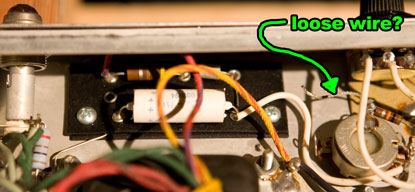Hi,
I have a late 70's Fender Deluxe Reverb. I have owned it for 12 years and it's been very reliable. Recently it has begun the habit of suddenly oscillating with a low hum.
I have built a few hobby amps etc but have no experience troubleshooting older amps.
It seems the problem only occurs after the amp has warmed up... so I am assuming it's thermal related.
I've pulled tubes and done some swaps but returned all the existing ones because nothing seemed to stop the trouble. I tried a Groove Tubes solid state rectifier "tube"replacement as well.
I just removed and replaced the 5 big B+ caps in the tray and 3 - 25mf-25vDc electrolytics on the preamp cathodes.
The problem seems to have become much less frequent... the caps were all 30ish years old... but I haven't eliminated it.
What would you recomend next?
Are coupling caps (orange drops) considered electrolytic? Should I start replacing those?
Thanks for any suggestions,
mike
I have a late 70's Fender Deluxe Reverb. I have owned it for 12 years and it's been very reliable. Recently it has begun the habit of suddenly oscillating with a low hum.
I have built a few hobby amps etc but have no experience troubleshooting older amps.
It seems the problem only occurs after the amp has warmed up... so I am assuming it's thermal related.
I've pulled tubes and done some swaps but returned all the existing ones because nothing seemed to stop the trouble. I tried a Groove Tubes solid state rectifier "tube"replacement as well.
I just removed and replaced the 5 big B+ caps in the tray and 3 - 25mf-25vDc electrolytics on the preamp cathodes.
The problem seems to have become much less frequent... the caps were all 30ish years old... but I haven't eliminated it.
What would you recomend next?
Are coupling caps (orange drops) considered electrolytic? Should I start replacing those?
Thanks for any suggestions,
mike

Comment